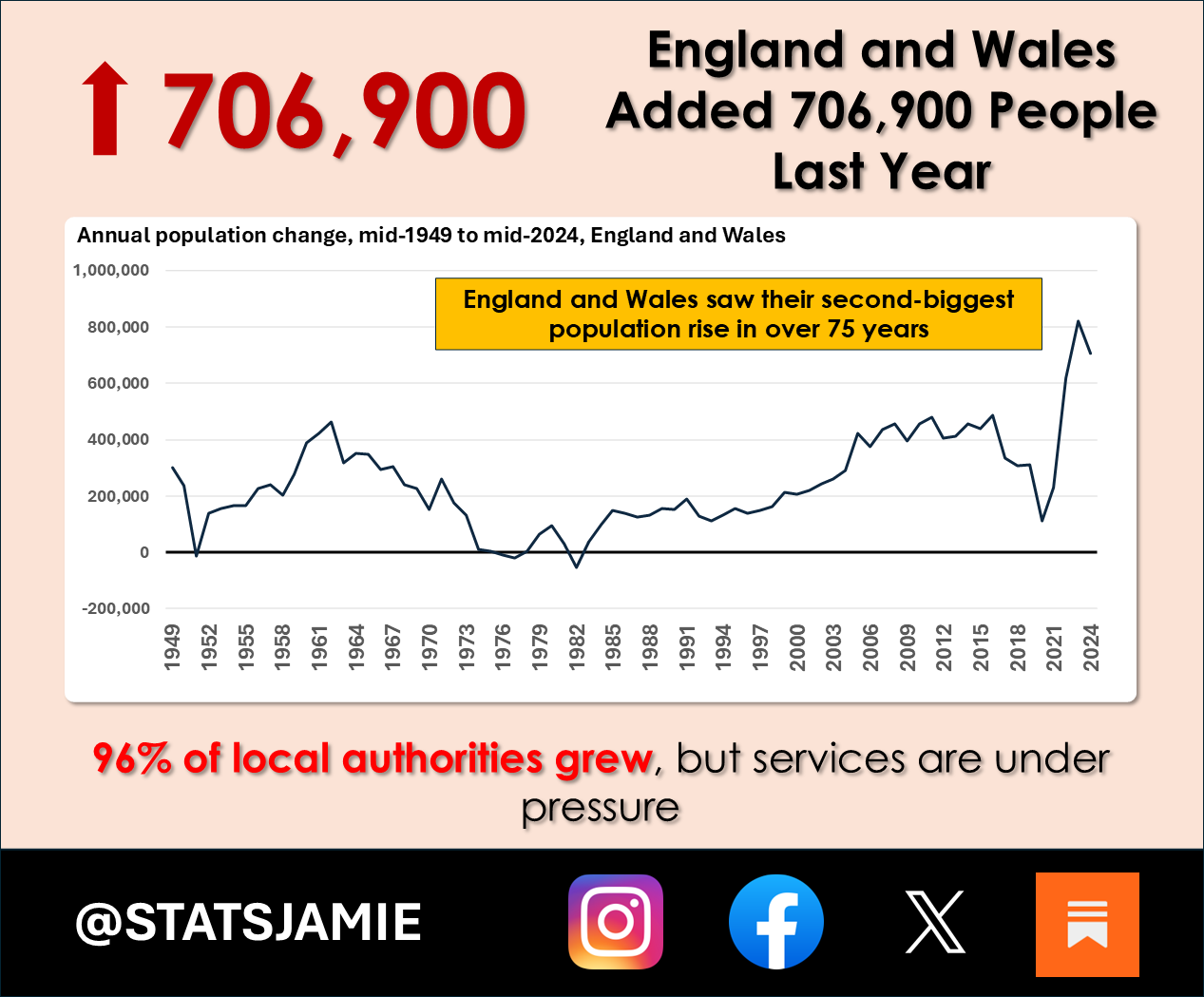England and Wales Just Added 700,000 People. And Services Are at Breaking Point
England and Wales saw their second-biggest population rise in over 75 years — 96% of local authorities grew, but services are under pressure
You’re not imagining it — your local area is getting more crowded, and everything feels more stretched. GP appointments are taking longer, schools are full, and good luck finding decent housing at a fair price. And yet, politicians just keep telling you everything’s fine.
But new data from the Office for National Statistics proves what you’ve been saying all along: the country is growing too fast — and it’s migration that’s driving it.
In just 12 months, the population of England and Wales jumped by over 700,000 people — one of the biggest increases in 75 years. That growth wasn’t fuelled by births. It wasn’t down to people living longer. It was overwhelmingly driven by net migration.
The system isn’t coping — and you’re the one paying the price. Services aren’t scaling, councils are overwhelmed, and politicians seem too scared to even talk about it properly.
Here’s what’s really going on.
What’s driving the numbers?
According to the ONS, the biggest driver of population growth last year was international migration. In the year to mid-2024:
1.14 million people moved to England and Wales
452,000 people left
That means net migration was +690,000
To put that in context, that’s like adding the entire population of Cornwall — and another 100,000 people on top — in just one year.
This isn’t a small change. It’s a demographic earthquake.
And while that’s slightly lower than the year before, it’s still sky-high compared to pre-pandemic levels. Migration has now been the main driver of population growth for over 20 years — and shows no signs of reversing.
Public services can’t keep up
You don’t need to look at a spreadsheet to know services are under pressure. You feel it.
Every extra 10-minute wait at A&E.
Every letter from the council says there’s no housing.
Every school that’s turning away local kids because it’s already full.
Here’s what it looks like on the ground:
GP surgeries buckling under patient loads
Councils scrambling for temporary accommodation — some putting families in hotels
Schools stretched to capacity, especially in high-growth areas
More potholes, slower bin collections, and overstretched social care
NHS waiting lists targets missed month after month
We’re adding the equivalent of a major city every year, but the services needed to support them are being left behind. You wouldn’t open a new airport and forget to build the runways. But that’s exactly what’s happening with population growth and public infrastructure.
This isn’t just a London issue
You might think, "Well, this is probably just the capital getting busier." But the data tells a different story.
96% of all local authorities saw population increases last year. That’s 306 out of 318 areas.
And some of the fastest growth was in towns and rural areas, not the usual big-city suspects:
Oadby and Wigston (+3.1%)
Preston (+2.9%)
Even places in the East Midlands, which used to be stable, are now seeing surges
It’s not just a pressure cooker in London — it’s boiling over in places that were never built for this pace of change. Villages turning into commuter belts. Market towns losing their identity. Locals priced out or squeezed out.
Migration is no longer a side issue. It is the issue.
Here’s the hard truth: only 30,000 of the 706,900 population increase came from natural change (births minus deaths). That’s less than 4%.
The other 96%? Migration.
Let that sink in: the overwhelming majority of population growth now comes from immigration. Not births. Not people living longer. Just more people arriving, year after year.
Birth rates have dropped to their lowest since 2002. Deaths are also down. But none of that matters when net migration alone adds more people than the entire population of Sheffield every year.
This isn’t a temporary spike. This is a trend. And if nothing changes, it’ll keep going — year after year.
So what happens now?
The ONS doesn’t make policy. It just lays out the facts.
And the facts are staring us in the face:
Our population is rising fast
Migration is the main driver
Public services can’t keep up
Politicians still refuse to deal with it
Early data for the second half of 2024 does suggest migration is starting to fall — but it’s still at historically high levels. That might sound reassuring in theory, but on the ground, the pressure hasn’t let up. Not even close.
The truth is, the country cannot cope with these numbers, and until serious action is taken, it will continue to erode the quality of life for everyone already here.
So the real question is: how long are we supposed to just put up with it?
Because without a proper cap, a plan, and real investment where it’s needed — this isn’t going to stabilise. It’s going to get worse.
And no amount of spin from Westminster can hide the reality: Britain is full. Not because we hate newcomers. But because our leaders failed to prepare.
And as always, it’s ordinary people who are left picking up the pieces.
Britain didn’t vote for chaos. It didn’t vote for overcrowded hospitals, unaffordable housing, and schools bursting at the seams. But that’s exactly what we’re getting — because no one in power is willing to say: enough is enough.
If you're tired of being ignored — and want to see real change — share this post, hit subscribe, and make your voice heard.
📢 Britain deserves better. Let’s start saying it louder.


